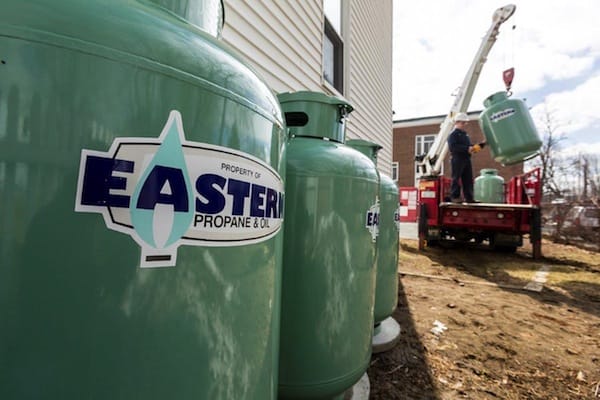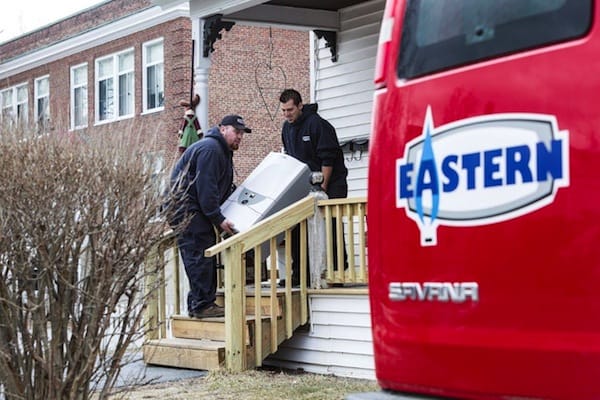 Last winter, residents of Claremont, NH, faced 72 inches of snow, with a walloping 31 inches that fell in February alone, creating a huge heating challenge for property owners like Mark Limoges.
Last winter, residents of Claremont, NH, faced 72 inches of snow, with a walloping 31 inches that fell in February alone, creating a huge heating challenge for property owners like Mark Limoges.
All that weather contributes to a hefty 7,800 heating degree days — 2,000 more than Boston, MA, just 100 miles to the south. That’s why Limoges was surprised to find that the big, 43-year-old, cast iron oil boiler that heated and produced domestic hot water for his two-apartment rental property could be replaced by a much smaller wall hung unit.
“The old oil boiler was installed in 1970,” said Limoges, who owns several rental properties in the Claremont area. “It had a tankless coil that filled a holding tank for domestic hot water. But the coil was calcified and boiler efficiency was 70 or 75 percent at best. The price of oil was killing me. It had to go.”
Given the big footprint of the boiler and tank, Limoges was surprised when Jeff Dillion, sales and marketing manager for Eastern Propane based in Rochester, NH, said he had a much more compact solution in mind.

The pre-assembled panel includes the Laars Mascot boiler/water heater combi unit and also includes copper supply and returns, with Taco 007 circs on the supply side, and spigots on the return for easy purging of zones, and for maintenance. A Taco 4900 air eliminator and was piped upstream from the Watts expansion tank, water feed and backflow preventer.
“Eastern has been in business serving New England since 1932,” explained Dillion. “We’ve seen a lot of winters come and go. That’s why we take boiler recommendations seriously. In this case, I know it’s a little surprising to hear that a compact cabinet on the wall can do the same job as a much larger, cast iron oil boiler and domestic hot water holding tank. But that’s the output you get from a super-efficient, wall-hung mod-con, just what Mark needed for his property.”
 Limoges was buying the replacement boiler for a two-story, two-apartment rental. “There’s a family with children in the upstairs apartment, and another family downstairs on the ground floor,” he noted. “Each floor is about 1,200 square feet with three bedrooms, a bath, and kitchen. So I needed a boiler that could heat the space and provide domestic hot water for two families with all the appliances — shower and bath, washing machine, dishwasher, and kitchen sink. I didn’t want to hear any complaints.”
Limoges was buying the replacement boiler for a two-story, two-apartment rental. “There’s a family with children in the upstairs apartment, and another family downstairs on the ground floor,” he noted. “Each floor is about 1,200 square feet with three bedrooms, a bath, and kitchen. So I needed a boiler that could heat the space and provide domestic hot water for two families with all the appliances — shower and bath, washing machine, dishwasher, and kitchen sink. I didn’t want to hear any complaints.”
 Reasons for energy efficiency in all seasons
Reasons for energy efficiency in all seasons
Given the heating and DHW load, Dillion recommended a 125 MBH Mascot “combi” boiler and water heater. “This unit’s a little giant in terms of capability, and I like that it’s made in the USA,” Dillion said. “It has a crucial spec you want to see for a job like this: a separate, on-demand DHW loop on the boiler with a substantial DHW flow rate, along with high capacity for high efficiency space heating.”
Unlike the previous cast iron oil boiler’s low efficiency, the new system achieves 95% (AFUE) by incorporating a stainless steel heat exchanger in a condensing design that harvests heat from combustion exhaust rather than losing it out the flue. Efficiency in radiant heating applications particularly gets a boost when return water temperature drops below 130°F – the greater the temperature drop, the more the exhaust condenses to boost boiler efficiency. To allow lower return temperature water to be used, the boiler provides a 5-to-1 turndown ratio. This feature permits the burner to operate with a lower firing rate to avoid raising water temperature higher than needed, which helps improve system efficiency.
 To ensure that DHW is available for showers and dishwasher, domestic water heating takes priority over the hydronic heating. A separate DHW stainless steel plate heat exchanger inside the unit produces 113 gallons of heated water per hour at 100° F temperature rise at a maximum flow rate of four GPM and a minimum of 0.5 GPM.
To ensure that DHW is available for showers and dishwasher, domestic water heating takes priority over the hydronic heating. A separate DHW stainless steel plate heat exchanger inside the unit produces 113 gallons of heated water per hour at 100° F temperature rise at a maximum flow rate of four GPM and a minimum of 0.5 GPM.
Easy energy savings during a hard winter
The “combi” Mascot configuration cut Limoges energy costs easily. For DHW heating, the ENERGY STAR program estimates that standby losses can represent 10 to 20 percent of a household’s water heating costs year around. Right out of the gate, the Mascot eliminated those loses by getting rid of the old holding tank that was losing heat while sitting in the cold, below-grade basement.
The boiler’s operational efficiency also saved Limoges a bundle. He calculates that even after one of the hardest winters on records — and with record LP fuel prices — he saved about $900 over the winter, with the total fuel bill eight percent lower than last year.
Limoges also was happy the replacement job went easily. Eastern Propane took care of removing the old boiler and tank by working through Twin Valley Heating, a firm managed by Mark’s son, Calvin Limoges, and Trevor Stickney.
To reduce field installation time, they built the boiler’s panel — complete with circulators, components and near boiler piping — at the shop. Key components included copper supply and returns, with Taco 007 circs on the supply side, and spigots on the return for easy purging of zones, and for maintenance. A Taco 4900 air eliminator and was piped upstream from the Watts expansion tank, water feed and backflow preventer.
“I really like using the 4900 air eliminators,” commented Limoges. “We’re fond of these because of their stainless steel pall rings to remove microbubbles in the system. They’re much more resistant to corrosion from chemicals in solution than units with internal brushes made of copper.”
Circulated fluids are tempered with a standard thermostatic mixing valve. The system’s three zones, each served by a 007, deliver heat to the single upstairs apartment, and to both lower apartments. “The circs are wired into the boiler control to respond to a call for heat from a programmable thermostat in each zone,” added Calvin Limoges.
“The boiler itself is just a 17-inch wide, 31-inch high, and 15-3/4-inch deep cabinet and weighs just 100 pounds,” added Limoges. “So it was real easy to carry into the house and downstairs into the basement without a hand truck. The compact size would fit into a closet or alcove – but in this case, it certainly took up less space in the basement than the old setup.”
After one of the toughest winters on record, Mark Limoges was pleased that the project was ready to go when the bad weather hit.
“I was happy to avoid what would have been a huge oil fuel bill this winter. My tenants were happy, too,” he said. “Knowing I had two families counting on this replacement system, I was glad to hear they were satisfied with the availability of heat and hot water rather than hear complaints in the dead of winter.”
Rachel Vastyan is account manager/writer & social media marketer at Common Ground. Rachel can be reached at cground3@ptd.net. Visit Common Ground at http://www.seekcg.com.










Join the conversation: